Project Management Plan: MidAmerican Energy Wind Turbine Project
VerifiedAdded on 2022/02/19
|19
|4392
|24
Report
AI Summary
This project management plan details the construction of a 2.1 MW wind turbine in Des Moines, Iowa, for MidAmerican Energy. It encompasses project scope management, goals, objectives, and a SWOT analysis. The plan outlines the work breakdown structure, project timeline, and budget, including a McKinsey 7s framework and communication strategy. Stakeholder analysis and a discussion of project challenges and opportunities are also included. The report addresses project assumptions, constraints, and acceptance criteria, aiming to deliver clean energy, promote renewable energy use, and achieve a good return on investment within a three-week timeframe and a $2.4 million budget. The plan emphasizes the importance of effective project management in overseeing all phases of the project, from site evaluation and construction to commissioning and operation, ensuring the project's successful completion and contribution to renewable energy goals.
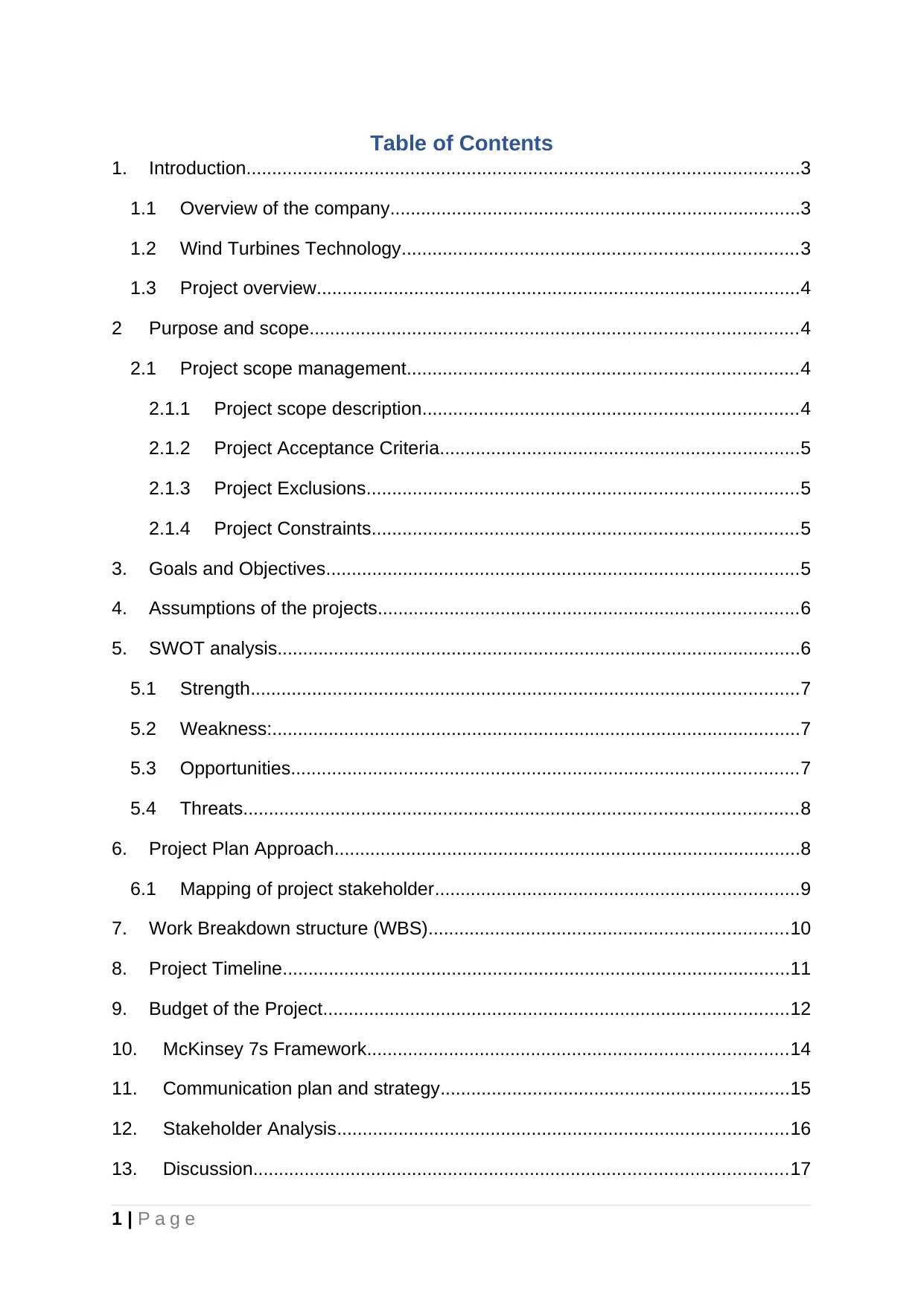
Table of Contents
1. Introduction............................................................................................................3
1.1 Overview of the company................................................................................3
1.2 Wind Turbines Technology.............................................................................3
1.3 Project overview..............................................................................................4
2 Purpose and scope...............................................................................................4
2.1 Project scope management............................................................................4
2.1.1 Project scope description.........................................................................4
2.1.2 Project Acceptance Criteria......................................................................5
2.1.3 Project Exclusions....................................................................................5
2.1.4 Project Constraints...................................................................................5
3. Goals and Objectives............................................................................................5
4. Assumptions of the projects..................................................................................6
5. SWOT analysis......................................................................................................6
5.1 Strength...........................................................................................................7
5.2 Weakness:.......................................................................................................7
5.3 Opportunities...................................................................................................7
5.4 Threats............................................................................................................8
6. Project Plan Approach...........................................................................................8
6.1 Mapping of project stakeholder.......................................................................9
7. Work Breakdown structure (WBS)......................................................................10
8. Project Timeline...................................................................................................11
9. Budget of the Project...........................................................................................12
10. McKinsey 7s Framework..................................................................................14
11. Communication plan and strategy....................................................................15
12. Stakeholder Analysis........................................................................................16
13. Discussion........................................................................................................17
1 | P a g e
1. Introduction............................................................................................................3
1.1 Overview of the company................................................................................3
1.2 Wind Turbines Technology.............................................................................3
1.3 Project overview..............................................................................................4
2 Purpose and scope...............................................................................................4
2.1 Project scope management............................................................................4
2.1.1 Project scope description.........................................................................4
2.1.2 Project Acceptance Criteria......................................................................5
2.1.3 Project Exclusions....................................................................................5
2.1.4 Project Constraints...................................................................................5
3. Goals and Objectives............................................................................................5
4. Assumptions of the projects..................................................................................6
5. SWOT analysis......................................................................................................6
5.1 Strength...........................................................................................................7
5.2 Weakness:.......................................................................................................7
5.3 Opportunities...................................................................................................7
5.4 Threats............................................................................................................8
6. Project Plan Approach...........................................................................................8
6.1 Mapping of project stakeholder.......................................................................9
7. Work Breakdown structure (WBS)......................................................................10
8. Project Timeline...................................................................................................11
9. Budget of the Project...........................................................................................12
10. McKinsey 7s Framework..................................................................................14
11. Communication plan and strategy....................................................................15
12. Stakeholder Analysis........................................................................................16
13. Discussion........................................................................................................17
1 | P a g e
Paraphrase This Document
Need a fresh take? Get an instant paraphrase of this document with our AI Paraphraser
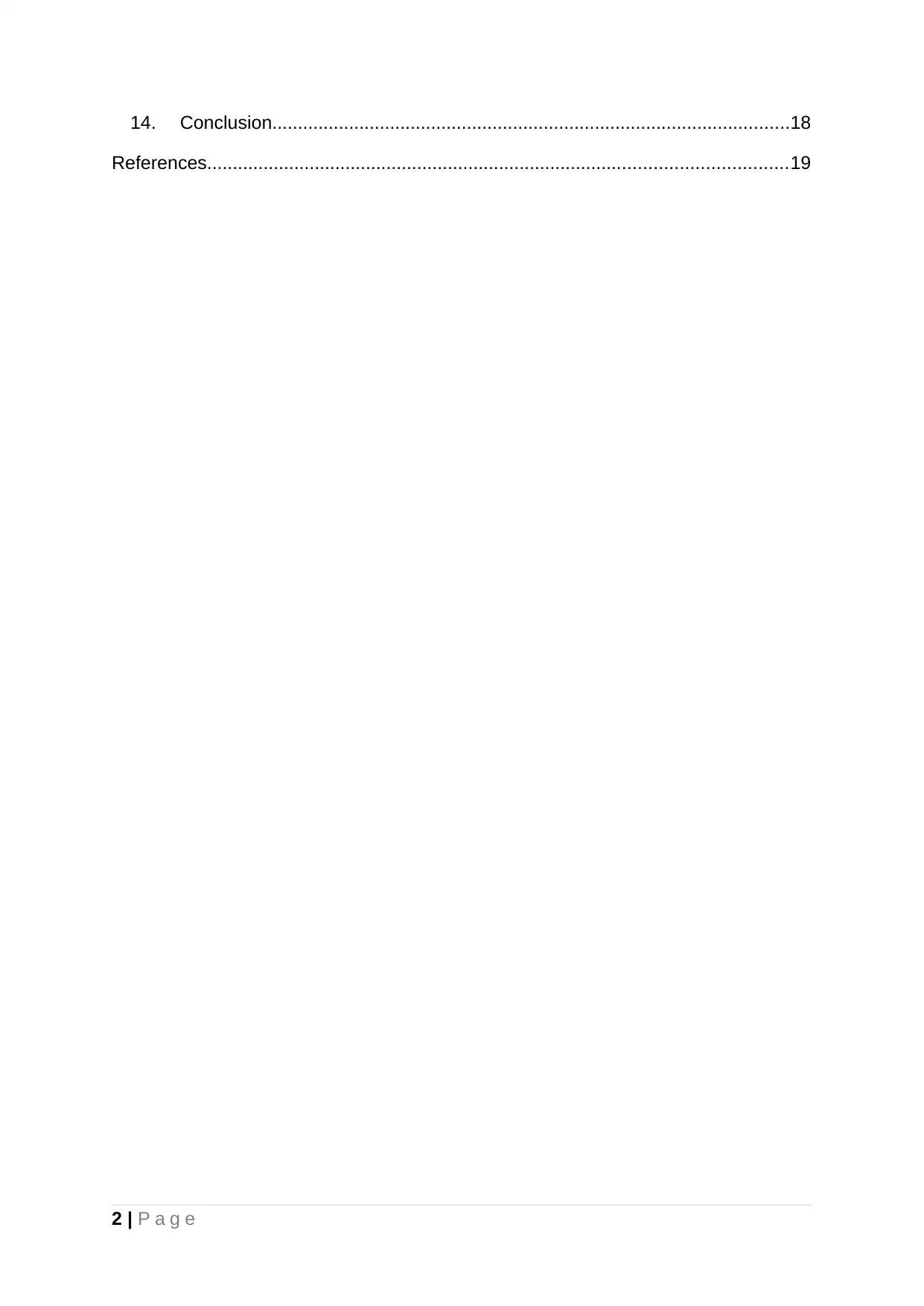
14. Conclusion.....................................................................................................18
References.................................................................................................................19
2 | P a g e
References.................................................................................................................19
2 | P a g e
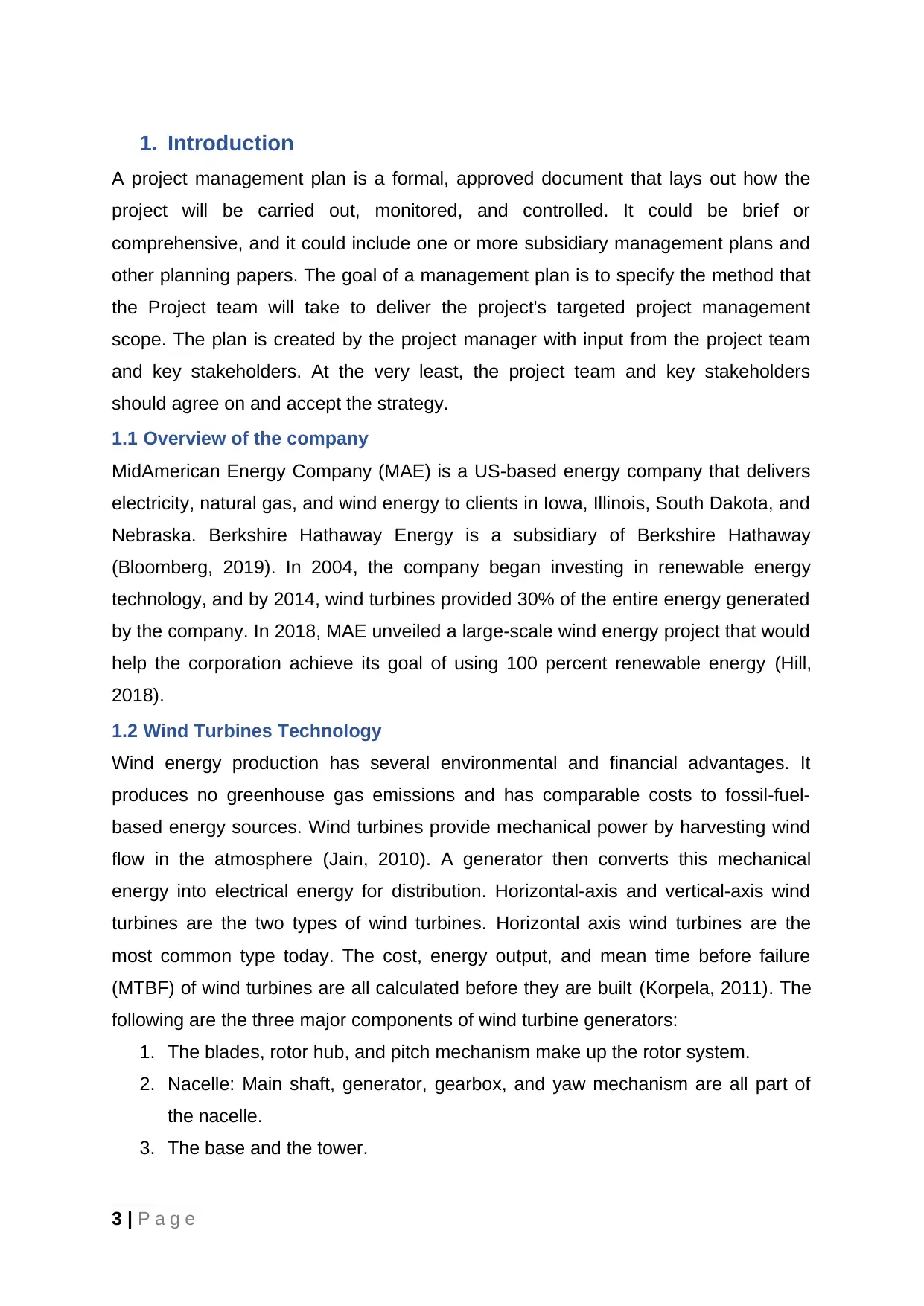
1. Introduction
A project management plan is a formal, approved document that lays out how the
project will be carried out, monitored, and controlled. It could be brief or
comprehensive, and it could include one or more subsidiary management plans and
other planning papers. The goal of a management plan is to specify the method that
the Project team will take to deliver the project's targeted project management
scope. The plan is created by the project manager with input from the project team
and key stakeholders. At the very least, the project team and key stakeholders
should agree on and accept the strategy.
1.1 Overview of the company
MidAmerican Energy Company (MAE) is a US-based energy company that delivers
electricity, natural gas, and wind energy to clients in Iowa, Illinois, South Dakota, and
Nebraska. Berkshire Hathaway Energy is a subsidiary of Berkshire Hathaway
(Bloomberg, 2019). In 2004, the company began investing in renewable energy
technology, and by 2014, wind turbines provided 30% of the entire energy generated
by the company. In 2018, MAE unveiled a large-scale wind energy project that would
help the corporation achieve its goal of using 100 percent renewable energy (Hill,
2018).
1.2 Wind Turbines Technology
Wind energy production has several environmental and financial advantages. It
produces no greenhouse gas emissions and has comparable costs to fossil-fuel-
based energy sources. Wind turbines provide mechanical power by harvesting wind
flow in the atmosphere (Jain, 2010). A generator then converts this mechanical
energy into electrical energy for distribution. Horizontal-axis and vertical-axis wind
turbines are the two types of wind turbines. Horizontal axis wind turbines are the
most common type today. The cost, energy output, and mean time before failure
(MTBF) of wind turbines are all calculated before they are built (Korpela, 2011). The
following are the three major components of wind turbine generators:
1. The blades, rotor hub, and pitch mechanism make up the rotor system.
2. Nacelle: Main shaft, generator, gearbox, and yaw mechanism are all part of
the nacelle.
3. The base and the tower.
3 | P a g e
A project management plan is a formal, approved document that lays out how the
project will be carried out, monitored, and controlled. It could be brief or
comprehensive, and it could include one or more subsidiary management plans and
other planning papers. The goal of a management plan is to specify the method that
the Project team will take to deliver the project's targeted project management
scope. The plan is created by the project manager with input from the project team
and key stakeholders. At the very least, the project team and key stakeholders
should agree on and accept the strategy.
1.1 Overview of the company
MidAmerican Energy Company (MAE) is a US-based energy company that delivers
electricity, natural gas, and wind energy to clients in Iowa, Illinois, South Dakota, and
Nebraska. Berkshire Hathaway Energy is a subsidiary of Berkshire Hathaway
(Bloomberg, 2019). In 2004, the company began investing in renewable energy
technology, and by 2014, wind turbines provided 30% of the entire energy generated
by the company. In 2018, MAE unveiled a large-scale wind energy project that would
help the corporation achieve its goal of using 100 percent renewable energy (Hill,
2018).
1.2 Wind Turbines Technology
Wind energy production has several environmental and financial advantages. It
produces no greenhouse gas emissions and has comparable costs to fossil-fuel-
based energy sources. Wind turbines provide mechanical power by harvesting wind
flow in the atmosphere (Jain, 2010). A generator then converts this mechanical
energy into electrical energy for distribution. Horizontal-axis and vertical-axis wind
turbines are the two types of wind turbines. Horizontal axis wind turbines are the
most common type today. The cost, energy output, and mean time before failure
(MTBF) of wind turbines are all calculated before they are built (Korpela, 2011). The
following are the three major components of wind turbine generators:
1. The blades, rotor hub, and pitch mechanism make up the rotor system.
2. Nacelle: Main shaft, generator, gearbox, and yaw mechanism are all part of
the nacelle.
3. The base and the tower.
3 | P a g e
⊘ This is a preview!⊘
Do you want full access?
Subscribe today to unlock all pages.

Trusted by 1+ million students worldwide
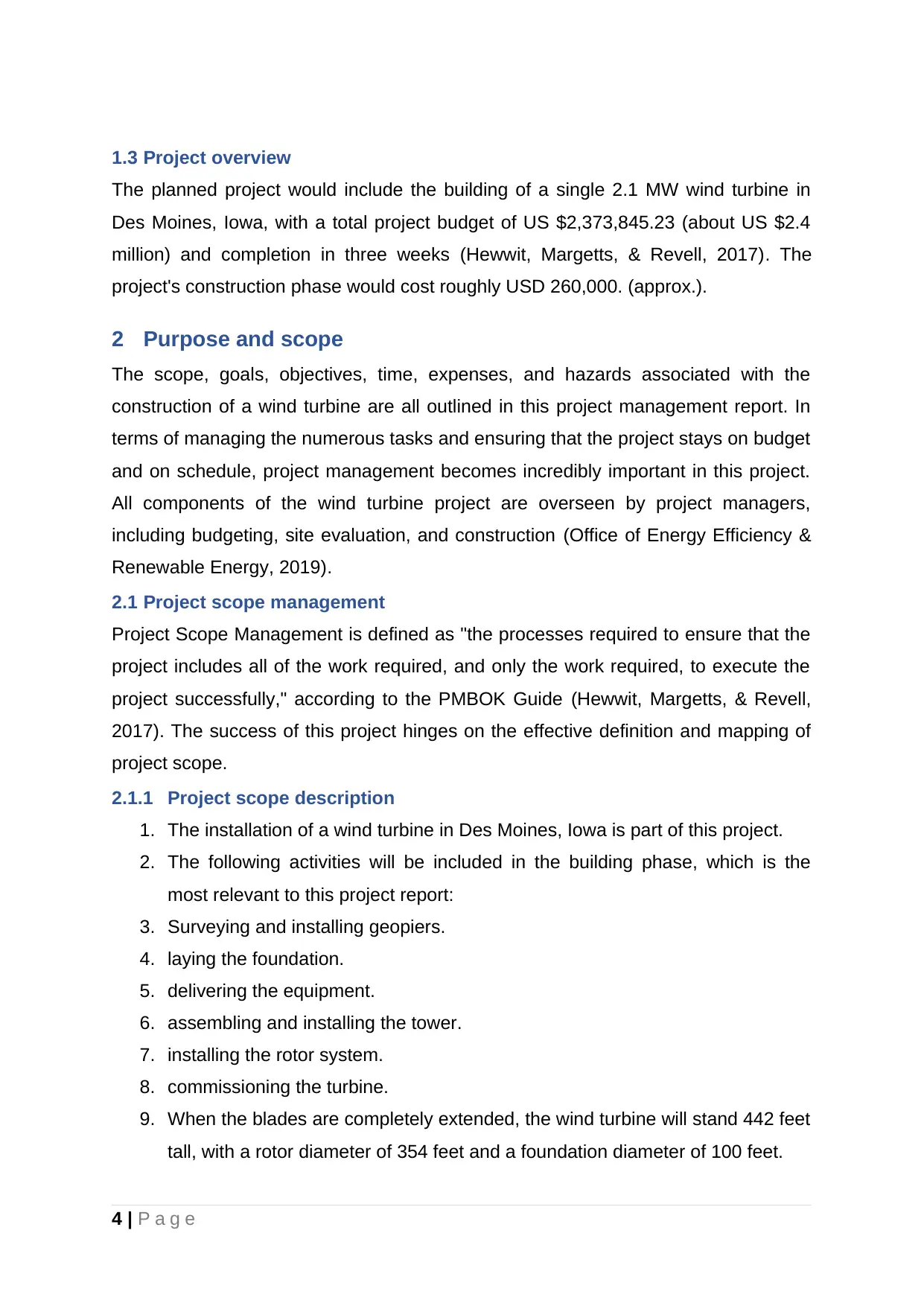
1.3 Project overview
The planned project would include the building of a single 2.1 MW wind turbine in
Des Moines, Iowa, with a total project budget of US $2,373,845.23 (about US $2.4
million) and completion in three weeks (Hewwit, Margetts, & Revell, 2017). The
project's construction phase would cost roughly USD 260,000. (approx.).
2 Purpose and scope
The scope, goals, objectives, time, expenses, and hazards associated with the
construction of a wind turbine are all outlined in this project management report. In
terms of managing the numerous tasks and ensuring that the project stays on budget
and on schedule, project management becomes incredibly important in this project.
All components of the wind turbine project are overseen by project managers,
including budgeting, site evaluation, and construction (Office of Energy Efficiency &
Renewable Energy, 2019).
2.1 Project scope management
Project Scope Management is defined as "the processes required to ensure that the
project includes all of the work required, and only the work required, to execute the
project successfully," according to the PMBOK Guide (Hewwit, Margetts, & Revell,
2017). The success of this project hinges on the effective definition and mapping of
project scope.
2.1.1 Project scope description
1. The installation of a wind turbine in Des Moines, Iowa is part of this project.
2. The following activities will be included in the building phase, which is the
most relevant to this project report:
3. Surveying and installing geopiers.
4. laying the foundation.
5. delivering the equipment.
6. assembling and installing the tower.
7. installing the rotor system.
8. commissioning the turbine.
9. When the blades are completely extended, the wind turbine will stand 442 feet
tall, with a rotor diameter of 354 feet and a foundation diameter of 100 feet.
4 | P a g e
The planned project would include the building of a single 2.1 MW wind turbine in
Des Moines, Iowa, with a total project budget of US $2,373,845.23 (about US $2.4
million) and completion in three weeks (Hewwit, Margetts, & Revell, 2017). The
project's construction phase would cost roughly USD 260,000. (approx.).
2 Purpose and scope
The scope, goals, objectives, time, expenses, and hazards associated with the
construction of a wind turbine are all outlined in this project management report. In
terms of managing the numerous tasks and ensuring that the project stays on budget
and on schedule, project management becomes incredibly important in this project.
All components of the wind turbine project are overseen by project managers,
including budgeting, site evaluation, and construction (Office of Energy Efficiency &
Renewable Energy, 2019).
2.1 Project scope management
Project Scope Management is defined as "the processes required to ensure that the
project includes all of the work required, and only the work required, to execute the
project successfully," according to the PMBOK Guide (Hewwit, Margetts, & Revell,
2017). The success of this project hinges on the effective definition and mapping of
project scope.
2.1.1 Project scope description
1. The installation of a wind turbine in Des Moines, Iowa is part of this project.
2. The following activities will be included in the building phase, which is the
most relevant to this project report:
3. Surveying and installing geopiers.
4. laying the foundation.
5. delivering the equipment.
6. assembling and installing the tower.
7. installing the rotor system.
8. commissioning the turbine.
9. When the blades are completely extended, the wind turbine will stand 442 feet
tall, with a rotor diameter of 354 feet and a foundation diameter of 100 feet.
4 | P a g e
Paraphrase This Document
Need a fresh take? Get an instant paraphrase of this document with our AI Paraphraser
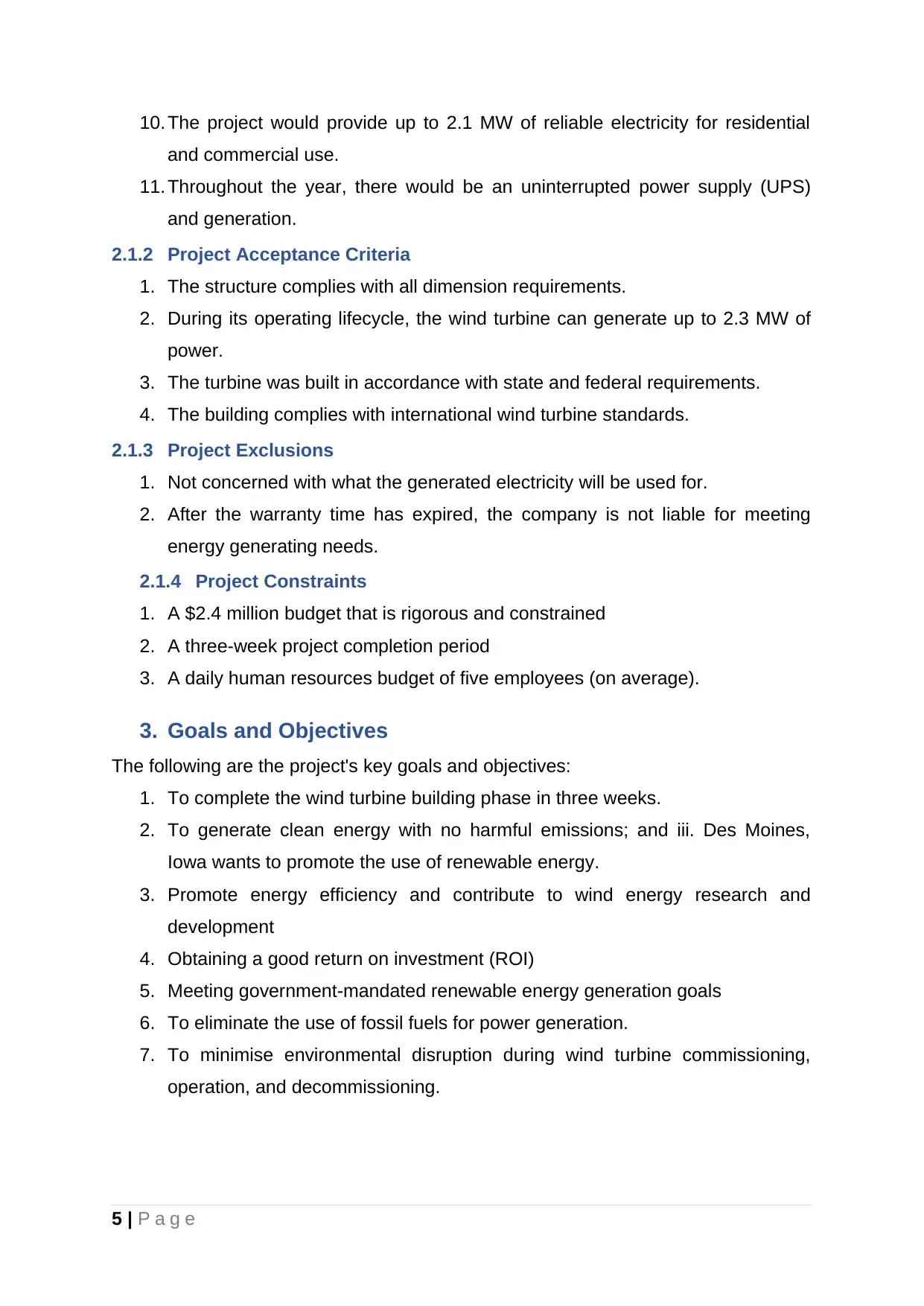
10. The project would provide up to 2.1 MW of reliable electricity for residential
and commercial use.
11. Throughout the year, there would be an uninterrupted power supply (UPS)
and generation.
2.1.2 Project Acceptance Criteria
1. The structure complies with all dimension requirements.
2. During its operating lifecycle, the wind turbine can generate up to 2.3 MW of
power.
3. The turbine was built in accordance with state and federal requirements.
4. The building complies with international wind turbine standards.
2.1.3 Project Exclusions
1. Not concerned with what the generated electricity will be used for.
2. After the warranty time has expired, the company is not liable for meeting
energy generating needs.
2.1.4 Project Constraints
1. A $2.4 million budget that is rigorous and constrained
2. A three-week project completion period
3. A daily human resources budget of five employees (on average).
3. Goals and Objectives
The following are the project's key goals and objectives:
1. To complete the wind turbine building phase in three weeks.
2. To generate clean energy with no harmful emissions; and iii. Des Moines,
Iowa wants to promote the use of renewable energy.
3. Promote energy efficiency and contribute to wind energy research and
development
4. Obtaining a good return on investment (ROI)
5. Meeting government-mandated renewable energy generation goals
6. To eliminate the use of fossil fuels for power generation.
7. To minimise environmental disruption during wind turbine commissioning,
operation, and decommissioning.
5 | P a g e
and commercial use.
11. Throughout the year, there would be an uninterrupted power supply (UPS)
and generation.
2.1.2 Project Acceptance Criteria
1. The structure complies with all dimension requirements.
2. During its operating lifecycle, the wind turbine can generate up to 2.3 MW of
power.
3. The turbine was built in accordance with state and federal requirements.
4. The building complies with international wind turbine standards.
2.1.3 Project Exclusions
1. Not concerned with what the generated electricity will be used for.
2. After the warranty time has expired, the company is not liable for meeting
energy generating needs.
2.1.4 Project Constraints
1. A $2.4 million budget that is rigorous and constrained
2. A three-week project completion period
3. A daily human resources budget of five employees (on average).
3. Goals and Objectives
The following are the project's key goals and objectives:
1. To complete the wind turbine building phase in three weeks.
2. To generate clean energy with no harmful emissions; and iii. Des Moines,
Iowa wants to promote the use of renewable energy.
3. Promote energy efficiency and contribute to wind energy research and
development
4. Obtaining a good return on investment (ROI)
5. Meeting government-mandated renewable energy generation goals
6. To eliminate the use of fossil fuels for power generation.
7. To minimise environmental disruption during wind turbine commissioning,
operation, and decommissioning.
5 | P a g e
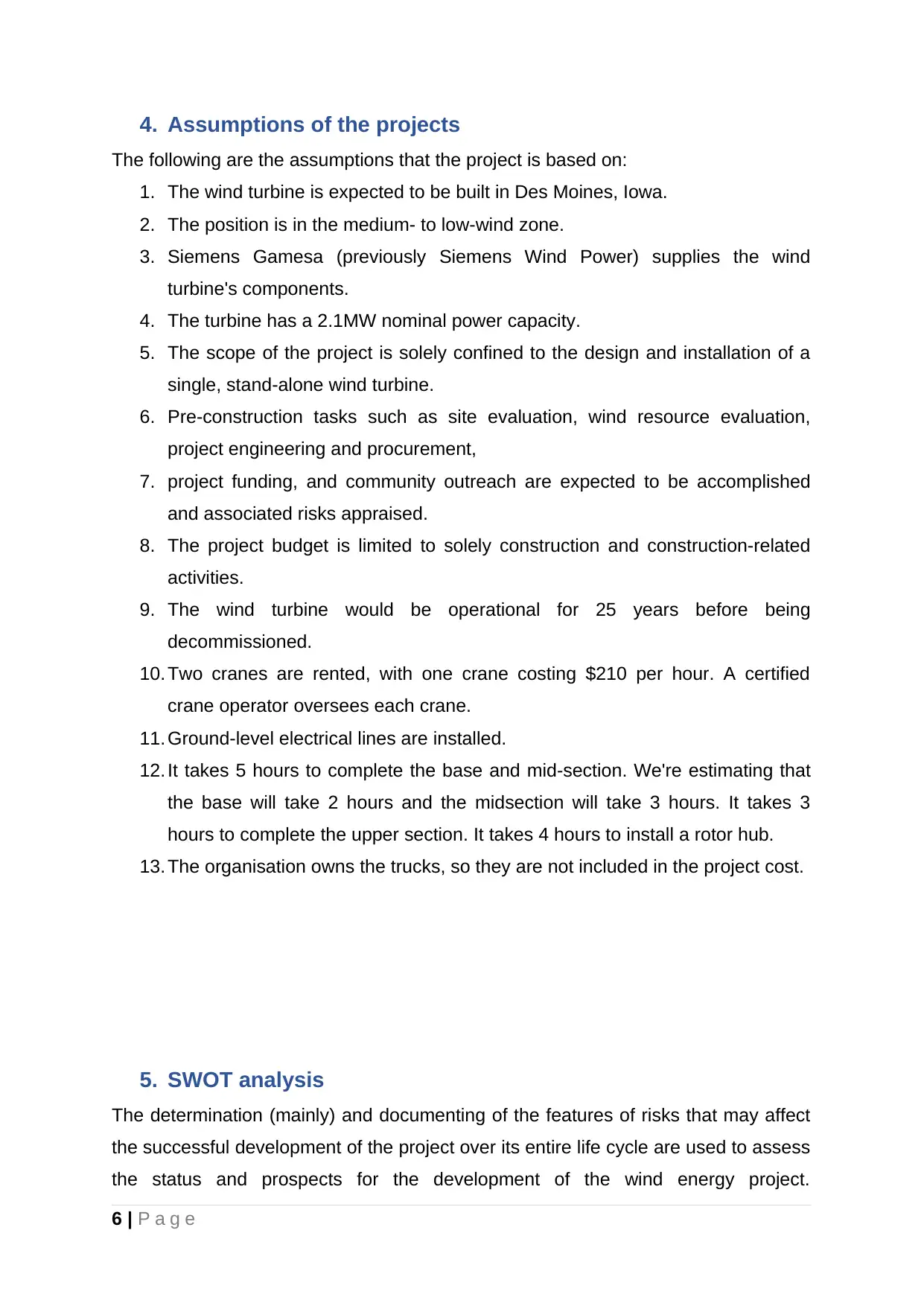
4. Assumptions of the projects
The following are the assumptions that the project is based on:
1. The wind turbine is expected to be built in Des Moines, Iowa.
2. The position is in the medium- to low-wind zone.
3. Siemens Gamesa (previously Siemens Wind Power) supplies the wind
turbine's components.
4. The turbine has a 2.1MW nominal power capacity.
5. The scope of the project is solely confined to the design and installation of a
single, stand-alone wind turbine.
6. Pre-construction tasks such as site evaluation, wind resource evaluation,
project engineering and procurement,
7. project funding, and community outreach are expected to be accomplished
and associated risks appraised.
8. The project budget is limited to solely construction and construction-related
activities.
9. The wind turbine would be operational for 25 years before being
decommissioned.
10. Two cranes are rented, with one crane costing $210 per hour. A certified
crane operator oversees each crane.
11. Ground-level electrical lines are installed.
12. It takes 5 hours to complete the base and mid-section. We're estimating that
the base will take 2 hours and the midsection will take 3 hours. It takes 3
hours to complete the upper section. It takes 4 hours to install a rotor hub.
13. The organisation owns the trucks, so they are not included in the project cost.
5. SWOT analysis
The determination (mainly) and documenting of the features of risks that may affect
the successful development of the project over its entire life cycle are used to assess
the status and prospects for the development of the wind energy project.
6 | P a g e
The following are the assumptions that the project is based on:
1. The wind turbine is expected to be built in Des Moines, Iowa.
2. The position is in the medium- to low-wind zone.
3. Siemens Gamesa (previously Siemens Wind Power) supplies the wind
turbine's components.
4. The turbine has a 2.1MW nominal power capacity.
5. The scope of the project is solely confined to the design and installation of a
single, stand-alone wind turbine.
6. Pre-construction tasks such as site evaluation, wind resource evaluation,
project engineering and procurement,
7. project funding, and community outreach are expected to be accomplished
and associated risks appraised.
8. The project budget is limited to solely construction and construction-related
activities.
9. The wind turbine would be operational for 25 years before being
decommissioned.
10. Two cranes are rented, with one crane costing $210 per hour. A certified
crane operator oversees each crane.
11. Ground-level electrical lines are installed.
12. It takes 5 hours to complete the base and mid-section. We're estimating that
the base will take 2 hours and the midsection will take 3 hours. It takes 3
hours to complete the upper section. It takes 4 hours to install a rotor hub.
13. The organisation owns the trucks, so they are not included in the project cost.
5. SWOT analysis
The determination (mainly) and documenting of the features of risks that may affect
the successful development of the project over its entire life cycle are used to assess
the status and prospects for the development of the wind energy project.
6 | P a g e
⊘ This is a preview!⊘
Do you want full access?
Subscribe today to unlock all pages.

Trusted by 1+ million students worldwide
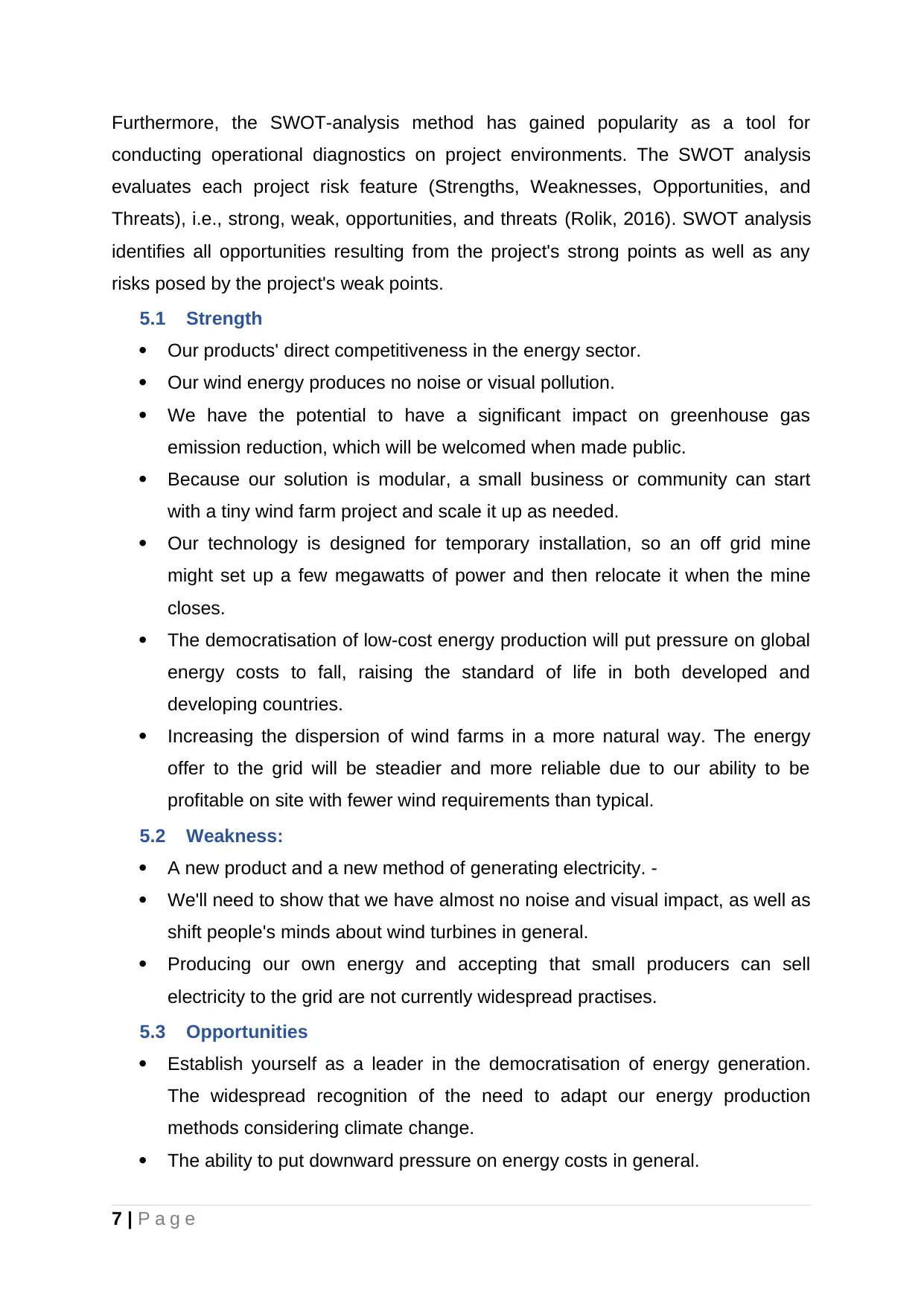
Furthermore, the SWOT-analysis method has gained popularity as a tool for
conducting operational diagnostics on project environments. The SWOT analysis
evaluates each project risk feature (Strengths, Weaknesses, Opportunities, and
Threats), i.e., strong, weak, opportunities, and threats (Rolik, 2016). SWOT analysis
identifies all opportunities resulting from the project's strong points as well as any
risks posed by the project's weak points.
5.1 Strength
Our products' direct competitiveness in the energy sector.
Our wind energy produces no noise or visual pollution.
We have the potential to have a significant impact on greenhouse gas
emission reduction, which will be welcomed when made public.
Because our solution is modular, a small business or community can start
with a tiny wind farm project and scale it up as needed.
Our technology is designed for temporary installation, so an off grid mine
might set up a few megawatts of power and then relocate it when the mine
closes.
The democratisation of low-cost energy production will put pressure on global
energy costs to fall, raising the standard of life in both developed and
developing countries.
Increasing the dispersion of wind farms in a more natural way. The energy
offer to the grid will be steadier and more reliable due to our ability to be
profitable on site with fewer wind requirements than typical.
5.2 Weakness:
A new product and a new method of generating electricity. -
We'll need to show that we have almost no noise and visual impact, as well as
shift people's minds about wind turbines in general.
Producing our own energy and accepting that small producers can sell
electricity to the grid are not currently widespread practises.
5.3 Opportunities
Establish yourself as a leader in the democratisation of energy generation.
The widespread recognition of the need to adapt our energy production
methods considering climate change.
The ability to put downward pressure on energy costs in general.
7 | P a g e
conducting operational diagnostics on project environments. The SWOT analysis
evaluates each project risk feature (Strengths, Weaknesses, Opportunities, and
Threats), i.e., strong, weak, opportunities, and threats (Rolik, 2016). SWOT analysis
identifies all opportunities resulting from the project's strong points as well as any
risks posed by the project's weak points.
5.1 Strength
Our products' direct competitiveness in the energy sector.
Our wind energy produces no noise or visual pollution.
We have the potential to have a significant impact on greenhouse gas
emission reduction, which will be welcomed when made public.
Because our solution is modular, a small business or community can start
with a tiny wind farm project and scale it up as needed.
Our technology is designed for temporary installation, so an off grid mine
might set up a few megawatts of power and then relocate it when the mine
closes.
The democratisation of low-cost energy production will put pressure on global
energy costs to fall, raising the standard of life in both developed and
developing countries.
Increasing the dispersion of wind farms in a more natural way. The energy
offer to the grid will be steadier and more reliable due to our ability to be
profitable on site with fewer wind requirements than typical.
5.2 Weakness:
A new product and a new method of generating electricity. -
We'll need to show that we have almost no noise and visual impact, as well as
shift people's minds about wind turbines in general.
Producing our own energy and accepting that small producers can sell
electricity to the grid are not currently widespread practises.
5.3 Opportunities
Establish yourself as a leader in the democratisation of energy generation.
The widespread recognition of the need to adapt our energy production
methods considering climate change.
The ability to put downward pressure on energy costs in general.
7 | P a g e
Paraphrase This Document
Need a fresh take? Get an instant paraphrase of this document with our AI Paraphraser
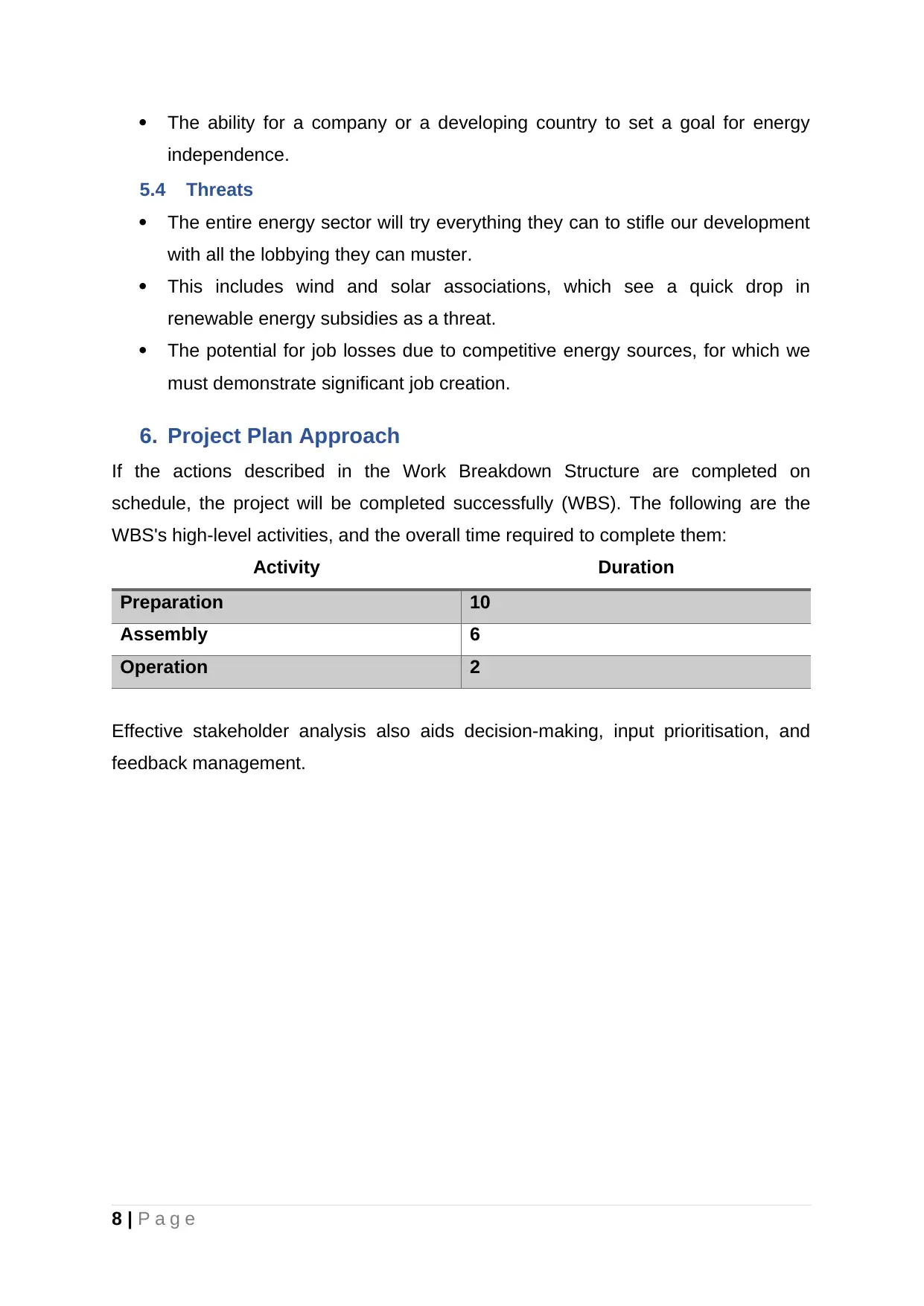
The ability for a company or a developing country to set a goal for energy
independence.
5.4 Threats
The entire energy sector will try everything they can to stifle our development
with all the lobbying they can muster.
This includes wind and solar associations, which see a quick drop in
renewable energy subsidies as a threat.
The potential for job losses due to competitive energy sources, for which we
must demonstrate significant job creation.
6. Project Plan Approach
If the actions described in the Work Breakdown Structure are completed on
schedule, the project will be completed successfully (WBS). The following are the
WBS's high-level activities, and the overall time required to complete them:
Activity Duration
Preparation 10
Assembly 6
Operation 2
Effective stakeholder analysis also aids decision-making, input prioritisation, and
feedback management.
8 | P a g e
independence.
5.4 Threats
The entire energy sector will try everything they can to stifle our development
with all the lobbying they can muster.
This includes wind and solar associations, which see a quick drop in
renewable energy subsidies as a threat.
The potential for job losses due to competitive energy sources, for which we
must demonstrate significant job creation.
6. Project Plan Approach
If the actions described in the Work Breakdown Structure are completed on
schedule, the project will be completed successfully (WBS). The following are the
WBS's high-level activities, and the overall time required to complete them:
Activity Duration
Preparation 10
Assembly 6
Operation 2
Effective stakeholder analysis also aids decision-making, input prioritisation, and
feedback management.
8 | P a g e
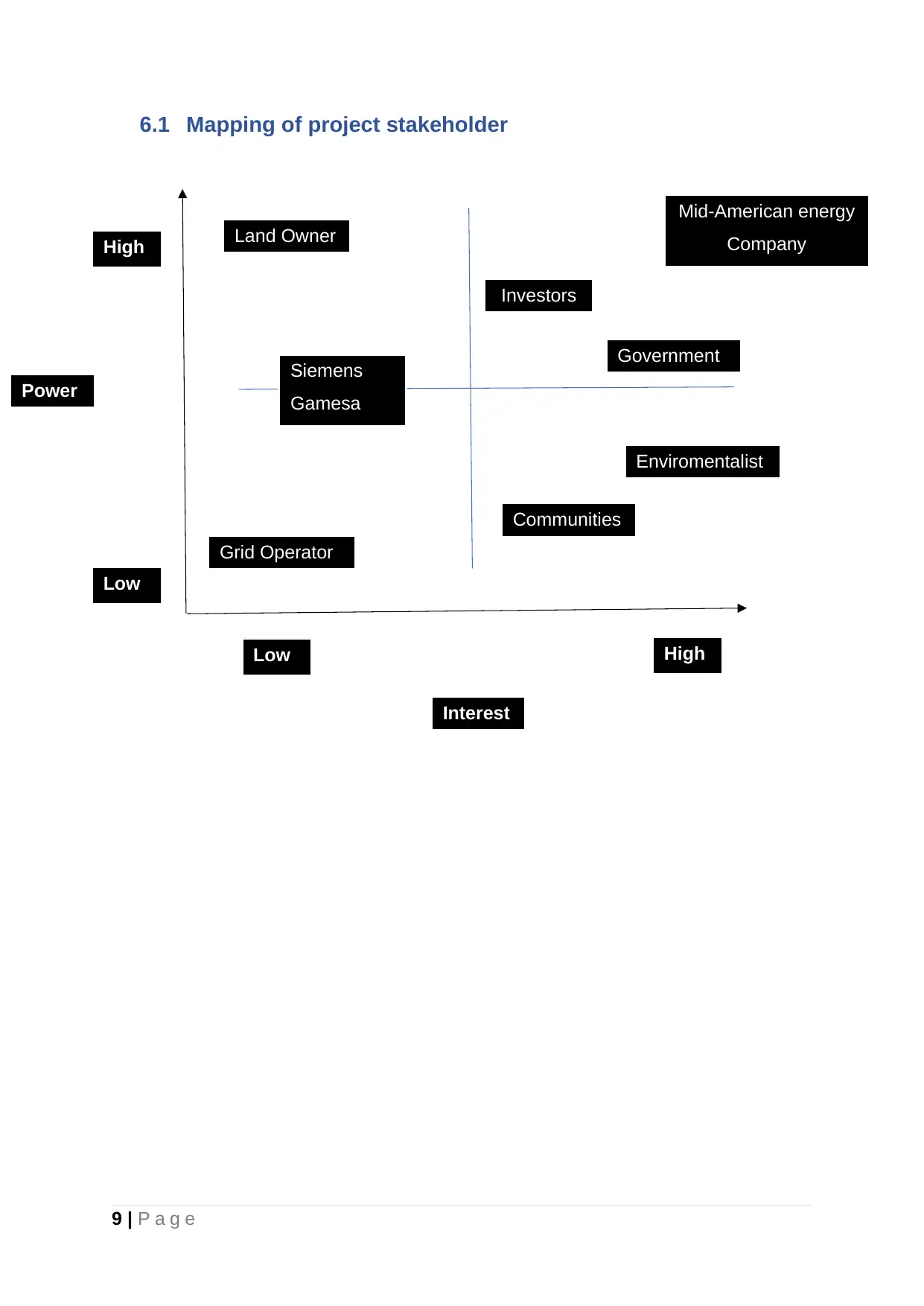
6.1 Mapping of project stakeholder
9 | P a g e
Land Owner
Enviromentalist
Grid Operator
Siemens
Gamesa
Government
Investors
Mid-American energy
Company
Power
HighLow
High
Low
Communities
Interest
9 | P a g e
Land Owner
Enviromentalist
Grid Operator
Siemens
Gamesa
Government
Investors
Mid-American energy
Company
Power
HighLow
High
Low
Communities
Interest
⊘ This is a preview!⊘
Do you want full access?
Subscribe today to unlock all pages.

Trusted by 1+ million students worldwide
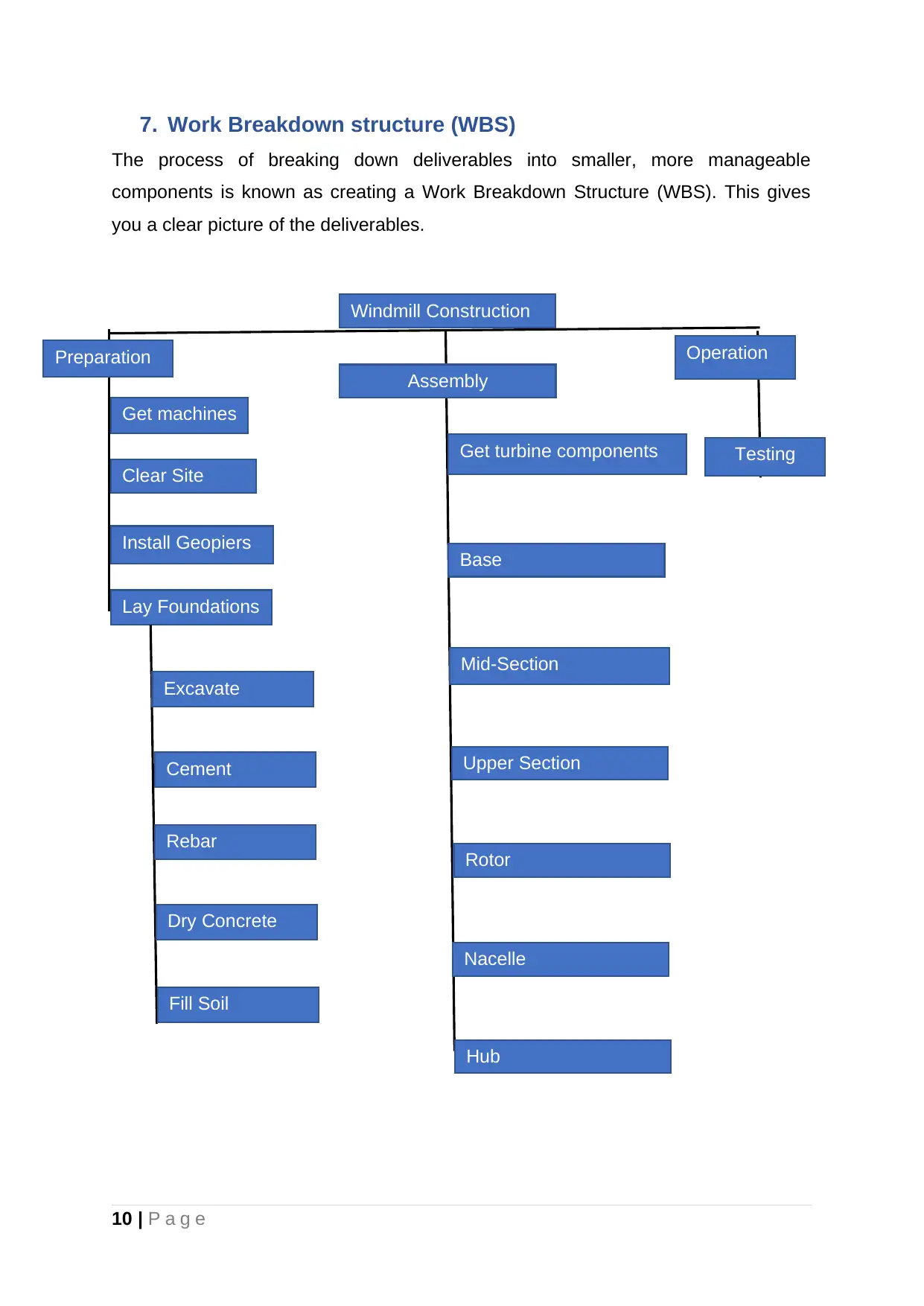
7. Work Breakdown structure (WBS)
The process of breaking down deliverables into smaller, more manageable
components is known as creating a Work Breakdown Structure (WBS). This gives
you a clear picture of the deliverables.
10 | P a g e
Windmill Construction
Assembly
Base
Mid-Section
Upper Section
Rotor
Nacelle
Hub
Clear Site
Get machines
Preparation
Install Geopiers
Lay Foundations
Excavate
Cement
Rebar
Dry Concrete
Fill Soil
Get turbine components Testing
Operation
The process of breaking down deliverables into smaller, more manageable
components is known as creating a Work Breakdown Structure (WBS). This gives
you a clear picture of the deliverables.
10 | P a g e
Windmill Construction
Assembly
Base
Mid-Section
Upper Section
Rotor
Nacelle
Hub
Clear Site
Get machines
Preparation
Install Geopiers
Lay Foundations
Excavate
Cement
Rebar
Dry Concrete
Fill Soil
Get turbine components Testing
Operation
Paraphrase This Document
Need a fresh take? Get an instant paraphrase of this document with our AI Paraphraser
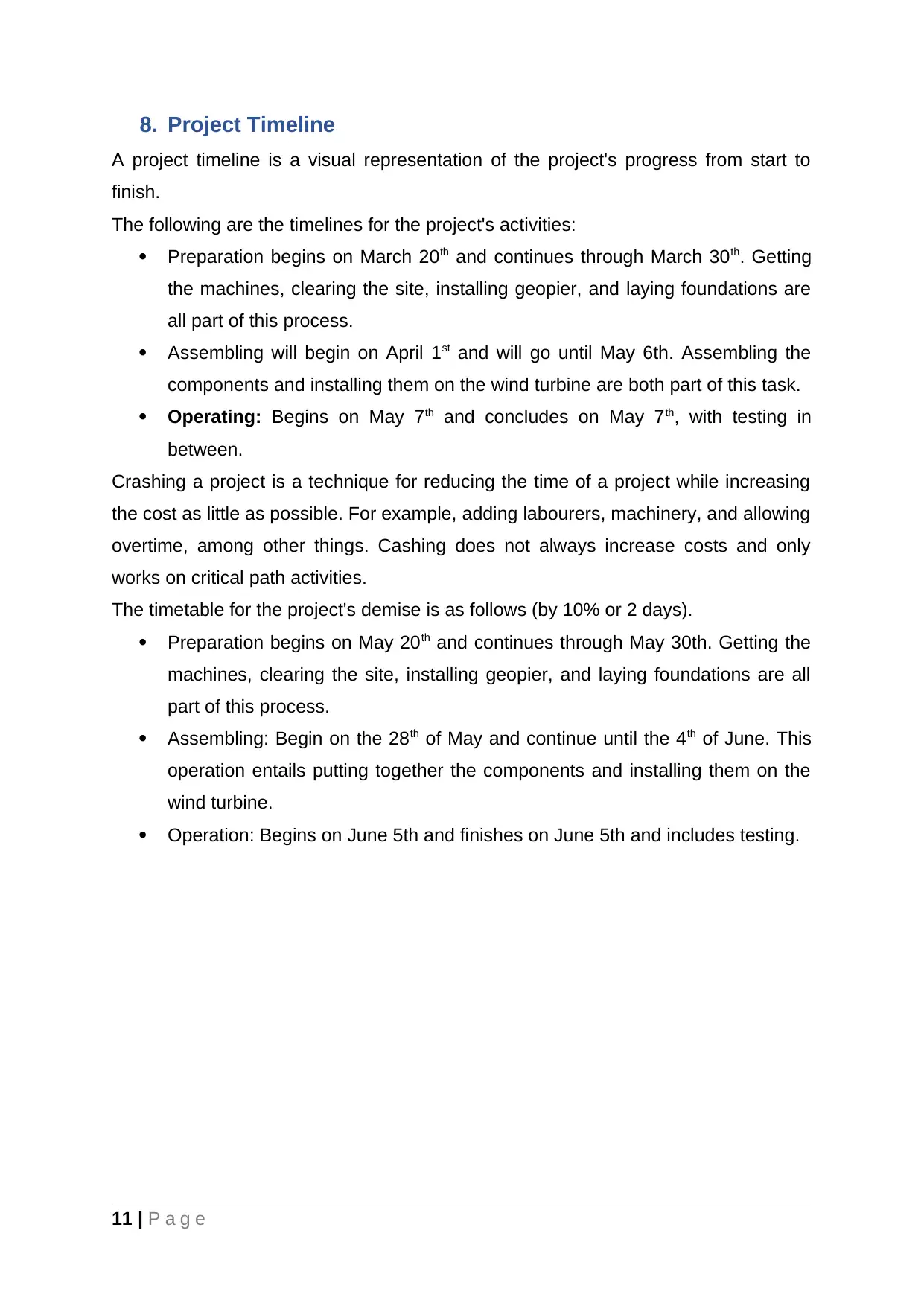
8. Project Timeline
A project timeline is a visual representation of the project's progress from start to
finish.
The following are the timelines for the project's activities:
Preparation begins on March 20th and continues through March 30th. Getting
the machines, clearing the site, installing geopier, and laying foundations are
all part of this process.
Assembling will begin on April 1st and will go until May 6th. Assembling the
components and installing them on the wind turbine are both part of this task.
Operating: Begins on May 7th and concludes on May 7th, with testing in
between.
Crashing a project is a technique for reducing the time of a project while increasing
the cost as little as possible. For example, adding labourers, machinery, and allowing
overtime, among other things. Cashing does not always increase costs and only
works on critical path activities.
The timetable for the project's demise is as follows (by 10% or 2 days).
Preparation begins on May 20th and continues through May 30th. Getting the
machines, clearing the site, installing geopier, and laying foundations are all
part of this process.
Assembling: Begin on the 28th of May and continue until the 4th of June. This
operation entails putting together the components and installing them on the
wind turbine.
Operation: Begins on June 5th and finishes on June 5th and includes testing.
11 | P a g e
A project timeline is a visual representation of the project's progress from start to
finish.
The following are the timelines for the project's activities:
Preparation begins on March 20th and continues through March 30th. Getting
the machines, clearing the site, installing geopier, and laying foundations are
all part of this process.
Assembling will begin on April 1st and will go until May 6th. Assembling the
components and installing them on the wind turbine are both part of this task.
Operating: Begins on May 7th and concludes on May 7th, with testing in
between.
Crashing a project is a technique for reducing the time of a project while increasing
the cost as little as possible. For example, adding labourers, machinery, and allowing
overtime, among other things. Cashing does not always increase costs and only
works on critical path activities.
The timetable for the project's demise is as follows (by 10% or 2 days).
Preparation begins on May 20th and continues through May 30th. Getting the
machines, clearing the site, installing geopier, and laying foundations are all
part of this process.
Assembling: Begin on the 28th of May and continue until the 4th of June. This
operation entails putting together the components and installing them on the
wind turbine.
Operation: Begins on June 5th and finishes on June 5th and includes testing.
11 | P a g e
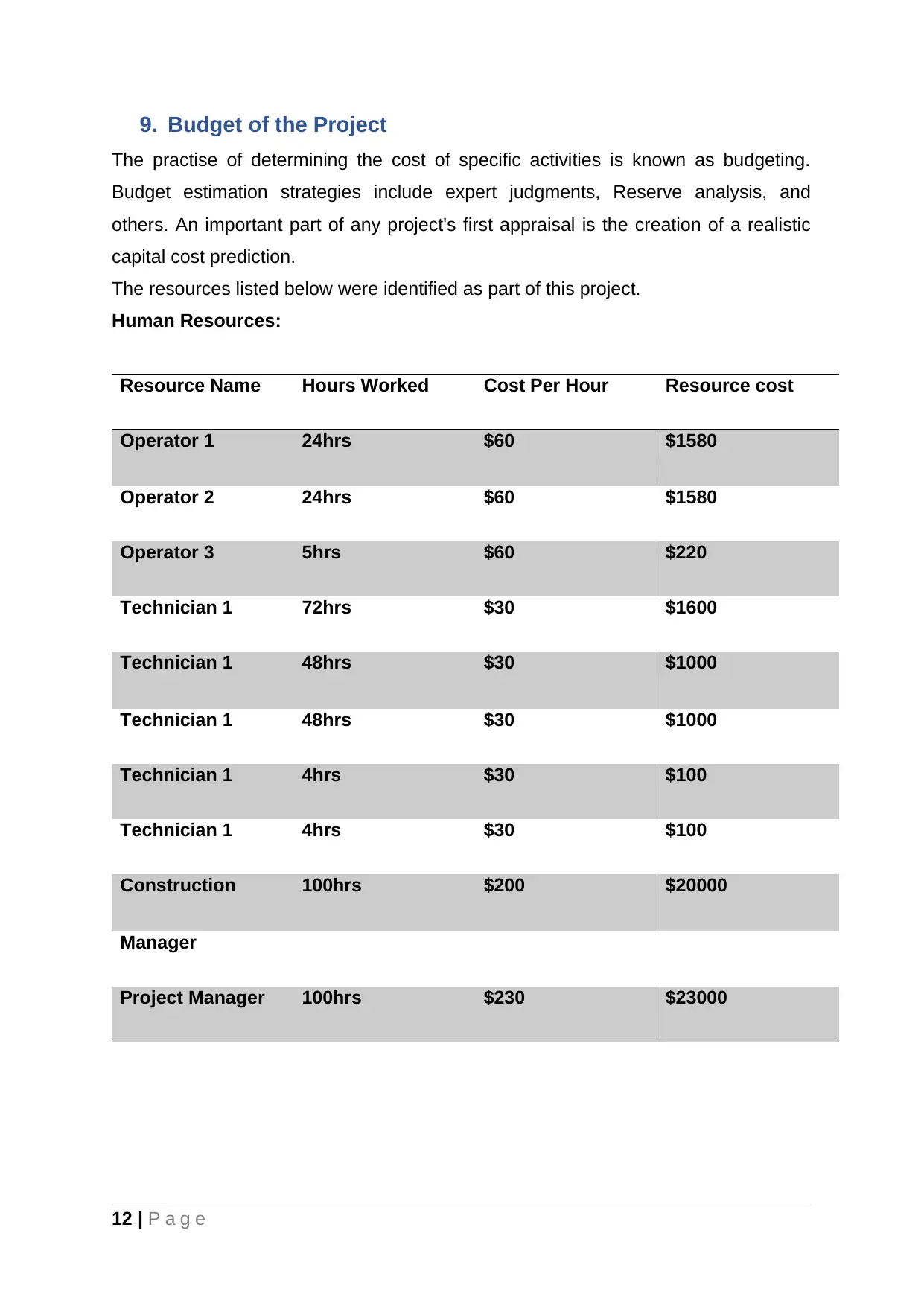
9. Budget of the Project
The practise of determining the cost of specific activities is known as budgeting.
Budget estimation strategies include expert judgments, Reserve analysis, and
others. An important part of any project's first appraisal is the creation of a realistic
capital cost prediction.
The resources listed below were identified as part of this project.
Human Resources:
Resource Name Hours Worked Cost Per Hour Resource cost
Operator 1 24hrs $60 $1580
Operator 2 24hrs $60 $1580
Operator 3 5hrs $60 $220
Technician 1 72hrs $30 $1600
Technician 1 48hrs $30 $1000
Technician 1 48hrs $30 $1000
Technician 1 4hrs $30 $100
Technician 1 4hrs $30 $100
Construction 100hrs $200 $20000
Manager
Project Manager 100hrs $230 $23000
12 | P a g e
The practise of determining the cost of specific activities is known as budgeting.
Budget estimation strategies include expert judgments, Reserve analysis, and
others. An important part of any project's first appraisal is the creation of a realistic
capital cost prediction.
The resources listed below were identified as part of this project.
Human Resources:
Resource Name Hours Worked Cost Per Hour Resource cost
Operator 1 24hrs $60 $1580
Operator 2 24hrs $60 $1580
Operator 3 5hrs $60 $220
Technician 1 72hrs $30 $1600
Technician 1 48hrs $30 $1000
Technician 1 48hrs $30 $1000
Technician 1 4hrs $30 $100
Technician 1 4hrs $30 $100
Construction 100hrs $200 $20000
Manager
Project Manager 100hrs $230 $23000
12 | P a g e
⊘ This is a preview!⊘
Do you want full access?
Subscribe today to unlock all pages.

Trusted by 1+ million students worldwide
1 out of 19
Your All-in-One AI-Powered Toolkit for Academic Success.
+13062052269
info@desklib.com
Available 24*7 on WhatsApp / Email
![[object Object]](/_next/static/media/star-bottom.7253800d.svg)
Unlock your academic potential
Copyright © 2020–2025 A2Z Services. All Rights Reserved. Developed and managed by ZUCOL.

